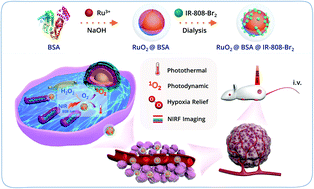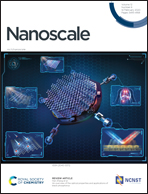Biomineralization-inspired nanozyme for single-wavelength laser activated photothermal-photodynamic synergistic treatment against hypoxic tumors†
Abstract
Hypoxia, one of the features of most solid tumors, can severely impede the efficiency of oxygen-dependent treatments such as chemotherapy, radiotherapy and type-II photodynamic therapy. Herein, a catalase-like nanozyme RuO2@BSA (RB) was first prepared through a biomineralization strategy, and a high efficiency near-infrared photosensitizer (IR-808-Br2) was further loaded into the protein shell to generate the safe and versatile RuO2@BSA@IR-808-Br2 (RBIR) for the imaging-guided enhanced phototherapy against hypoxic tumors. RB not only acts like a catalase, but also serves as a photothermal agent that speeds up the oxygen supply under near-infrared irradiation (808 nm). The loaded NIR photosensitizer could immediately convert molecular oxygen (O2) to cytotoxic singlet oxygen (1O2) upon the same laser irradiation. Results indicated that RBIR achieved enhanced therapeutic outcomes with negligible side effects. Features such as a simple synthetic route and imaging-guided and single-wavelength-excited phototherapy make the nanozyme a promising agent for clinical applications.



 Please wait while we load your content...
Please wait while we load your content...